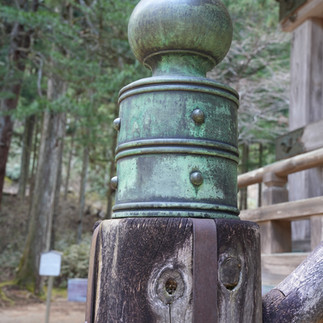MOUNT KOYA
- chuckmeltzer
- Jun 4
- 2 min read
Updated: Jun 24
Mount Koya is the central hub of the Shingon Buddhist sect. Buddhism consists of three primary schools: Theravada, Mahayana, and Vajrayana, each with numerous sects, subsects, and movements. The core tenets of Buddhism focus on understanding suffering, identifying its causes, and pursuing a path to liberation through mindfulness, compassion, and ethical behavior, all aimed at achieving nirvana (enlightenment).
We wandered through an enchanting cemetery nestled among towering cedars and moss. To my friends from Northern California, the forest resembled Armstrong Woods. The Okuno-in cemetery houses the tombs of over 200,000 samurai warriors amidst numerous shrines.
A recurring architectural feature seen throughout Japan is the five-stone shrine or 5-tiered pagoda.
These shrines are closely linked to Buddhist tradition. The elements from bottom to top are:
· Earth - typically square-shaped
· Water - spherical
· Fire - triangular
· Wind - half-moon shaped
· Space - gem-shaped
We journeyed on to Kongobuji, the chief temple of the Mount Koya monastery.
The rock garden is the largest in Japan and depicts a pair of dragons emerging from a sea of clouds.
At Kongobuji, we also saw works by artists of the Kano school of painting.
We stayed at the Shojoshin Inn, a working monastery.
We settled into our basic monastic accommodations, and although there was beauty in its simplicity, this was as close to camping as I'll ever get. We slept on very flat, hard futons placed on tatami mats, and had a space heater that shut off after 20 minutes. The quilts, designed for shorter Japanese people, were even too short for short me, making it difficult to keep both my feet and neck warm.
Dinner was fun in a somewhat masochistic way, as we sat on the floor and did our best to find a lotus position that these old hips could handle.
We enjoyed a traditional Buddhist vegetarian dinner, which I found quite good. However, my husband struggled with it since he was already tired of Asian cuisine, something we anticipated would be a challenge for him on this trip. On the bright side, we both lost a few pounds during our travels!
At the monastery the following morning, we had the opportunity to participate in morning prayers led by the Buddhist monks. There was a lot of chanting, which wasn't too lengthy or particularly engaging to me, but it felt and sounded spiritual. I don't think it is in me to become Buddhist and achieve enlightenment through repetitive chants which I find mind-numbing, but I on a related topic, I do appreciate the benefits of meditation.

















































Comments